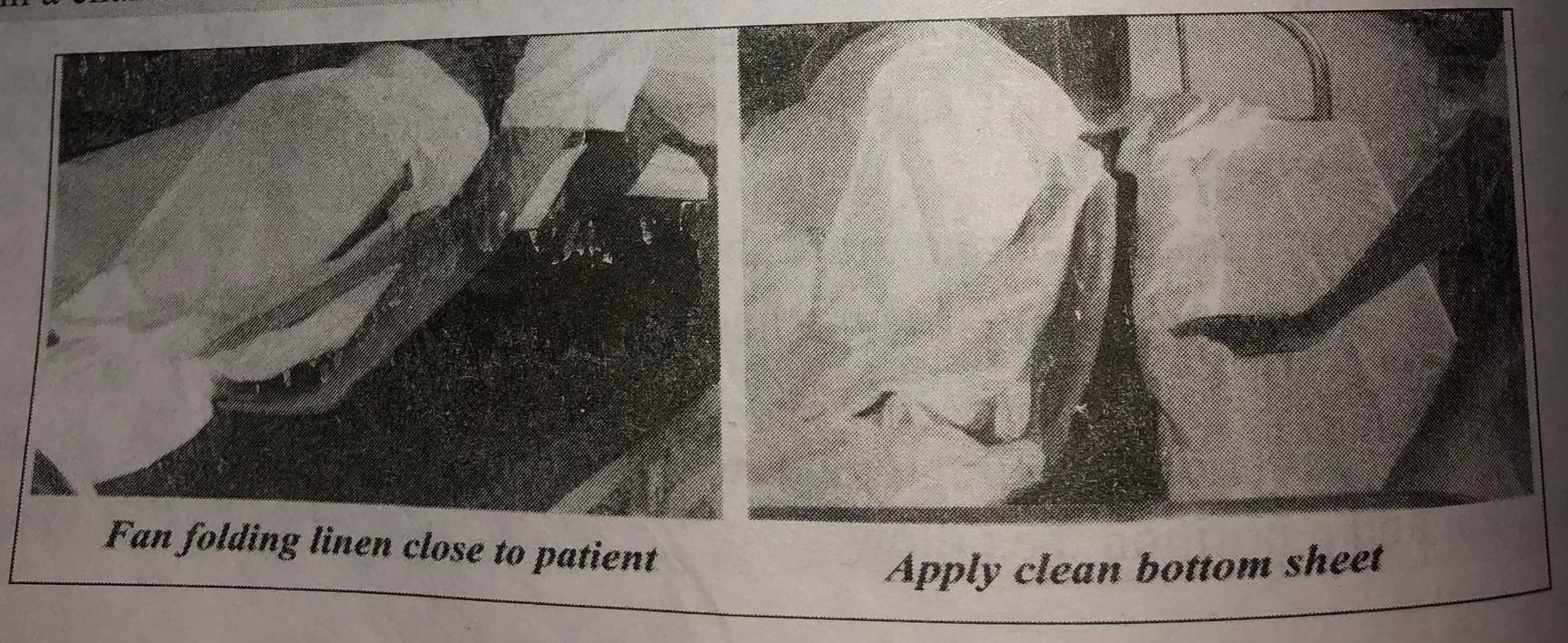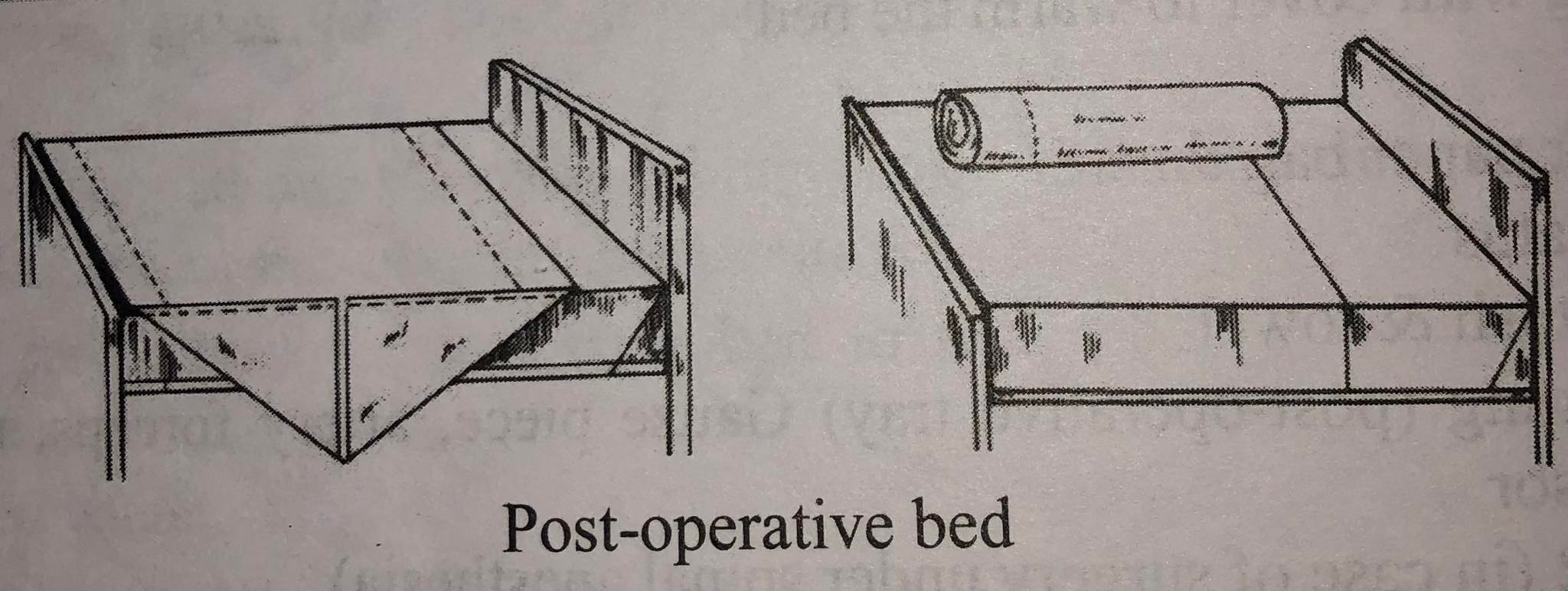Open Bed Making (For New Patient)
Subject: Fundamentals of Nursing

Overview
Open Bed Making (For New Patient)
Articles
- All articles of the simple bed.
- Hot water bags with cover.
- TPR tray.
- Cotton dresses 1 pair.
- Weight machine.
- Suction if needed.
- Sponge bath set if needed.
Procedures
- The bed is prepared as an open bed.
- Hot water bags are kept one at head end, one at the middle of the bed, and one at lower end of the bed.
- While receiving the patient hot water bags should be removed.
Occupied Bed Making
A hospital bed, which is occupied by the patient, is called an occupied bed. Occupied bed is made with the patient, for a patient who cannot get out of the bed. It is usually done by two persons.
Purposes
- To provide comfort for patients.
- To change the soiled bed linen for the bed ridden patients.
- To maintain neat appearance and clean environment.
- To provide a smooth wrinkle free bed thus minimizing source of skin irritation.
Procedure
| S.N. | Nursing Action | Rationale |
| 1 | Assess the patient's general condition and check for any limitation in physical activity. | Determines level of activity and ensures patient's safety during the procedure. |
| 2 | Explain the patient the need for bed making. | Facilitates patient's cooperation. |
| 3 | Wash hands. | Prevents spread of microorganisms. |
| 4 |
Collect required articles and bring the articles to the bed side.
|
Organized efforts facilitate ease of performance of task. |
| 5 | Close the door or curtain or screen the patient. | Provides privacy. |
| 6 | Adjust the height of the bed. Lower side rails near to you, leaving the opposite side rails up. Release any equipment attached to the bed linen with clips like tubes, drains. |
Adjusting height of bed reduces strain and maintains body mechanics. Releasing equipment attached to bed linen prevents discomfort and accidental dislodgement of the tubes. |
| 7 | Put on gloves if linens are soiled. | Prevents from cross infection. |
| 8 | Check bed linen for patient's personal items. | Avoids loss of personal items. |
| 9 |
Remove extra pillows. Loosen top linen at foot of bed. Remove blanket leaving the top sheet over the patient. If blanket is to be reused, fold lengthwise and keep on the chair/trolley. |
Avoids loss of personal items. Makes removal of blanket easier. Lengthwise folding prevents contamination of head end of sheet. |
| 10 |
Position the patient one side on the far side of the bed facing away. Adjust the pillow under the head. Be sure that the farthest side rails are up. If the patient is very ill, call for assistance. |
Position the patient to the side allows space for placement of fresh bed linen. Side rails ensure safety. |
| 11 |
Loosen the bottom linens moving from the head to the foot end. Fan fold the draw sheet towards the patient and push it as close to the patient as possible. Clean and roll the mackintosh towards the patient. Fan fold the bottom sheet towards the patient pushes it as close to the patient as possible. |
Provides maximum work space for placing clean linen. When the patient turns to the other side these soiled linen can be easily removed. |
| 12 | Clean the bed mattress with damp and dry duster. | Dusting minimizes the number of microorganisms. |
| 13 |
Place clean bottom sheet. Place clean bottom sheet which is fan folded lengthwise to the exposed half of the bed, keeping the centerfold in center of the bed. Smoothen the bottom layer over the mattress and bring edge over near side. Allow the sheets to hang about 25 cm over the mattress edge. Tuck the head end, make mitered corner at the top and bottom and tuck sides as in closed bed. Bring the mackintosh back into place. Place the clean draw sheet over the mackintosh and tuck both mackintosh and draw sheet under the mattress. Raise the side rails on working side |
Promotes comfort. Protects bed linen from soiling. Maintains safety. |
| 14 |
Move to the other side. Lower the side rails. Assist the patient to roll slowly to the other side of bed. You may need additional help if client is unable to move easily. |
Exposes opposite side of bed for removal of soiled linen and placement of clean linen. |
| 15 |
Move pillow under client's head. Loosen the edges of the soiled linen from underneath the mattress. Remove the draw sheet by folding it into a bundle and place in the linen bag. Remove the bottom sheet and put it in linen bag. Clean and roll mackintosh towards the patient. Clean the bed and mattress with damp and dry duster.
|
Makes linen easier to remove. Dusting minimizes the number of microorganisms. |
| 16 |
Grasp edge of fan folded bottom sheet and pull from under the client. Spread clean linen smoothly over the edge of the mattress from lie on. head end to foot end and make mitered corner. Pull side of the sheet taut and tuck under the side of the mattress. Straighten the mackintosh and draw sheet. Tuck the mackintosh and draw sheet in the same matter. |
Removes wrinkles and creases in linen, which are uncomfortable to lie on. Smooth linen will not irritate patient's skin. |
| 17 | Assist the patient in rolling back to supine position and reposition the pillow. | Maintains ptient's comfort. |
| 18 |
Place the top sheet over the patient with centerfold lengthwise down the middle of the bed. Open the sheet from head to foot and unfold it over the patient. Ask the patient to hold the top sheet and tuck around the shoulders. Remove the used top sheet by pulling from down and place it in the linen bag. Place the blanket over the top sheet as in an unoccupied bed. Place the upper edge of blanket 5-6 inch lower than the top sheet as in unoccupied. Fold it over the blanket's upper border to form a cuff. |
Top sheet prevents exposure of = body parts. Provides warmth for the patient. Having patient hold the sheet encourages participation in care. Covering the upper edge of blanket avoids irritation from direct contact of patient's skin with blanket. |
| 19 | Make a horizontal toe plate and modified mitered corner in the foot end allowing the sides hang free. |
Tucking the linen gives neat appearance and toe pleat provides adequate room for the legs under the sheet. Maintains neat appearance. |
| 20 | Change the pillowcase and replace pillow with open end facing away from door or entrance to room. | Maintains neat appearance. |
| 21 | Place the call signal and all other tubing back and place the patient in a comfortable position. | Ensures safety and comfort. |
| 22 |
Raise side rail, adjust the height of bed to a comfortable position. Lock the bed wheel. |
|
| 23 |
Open room curtains and rearrange furniture. Place personal items within easy reach on over bed table. |
|
| 24 | Replace articles. Discard linen according to agency's policy. |
Makes well setting for next use. Prevents the spread of infection. |
| 25 | Take vital signs. Record the observations made on the patient in the nurse note. | Provides accurate documentation. |
| 26 |
Wash hands. Document your actions and the client's response during the procedure and to sitting up in a chair. |

Special Consideration
The patient with respiratory and cardiac disorders may be unable to tolerate lying flat during bed making.
Post-Operative Bed Making
It is a special bed prepared to receive and take care of a patient returning from surgery. It is prepared for a patient who is recovering from the effects of anesthesia following a surgical operation.
Purposes
- To provide a safe, clean and comfortable bed for a postoperative patient.
- To provide appropriate position to the patient who has undergone an operation.
- For quick transfer of patient from trolley.
- To prepare to meet any emergency.
- To provide warmth.
- To protect the mattress and bedding from bleeding, vomiting, drainage and discharges.
Articles
- All the articles required for simple bed.
- Vitals sign tray.
- Hot water bag with cover to warm the bed.
- IV stand.
- Kidney tray & paper bag.
- Suction apparatus.
- Small mackintosh & towel.
- A tray containing (post-operative tray) Gauze piece, artery forceps, mouth gag, airway, tongue depressor.
- Bed blocks -2 (in case of surgery under spinal anesthesia).
- Article needed for O2 administration.
Procedure
| S.N. | Nursing Action | Rationale |
| 1 | Ascertain the need for bed making. | Provides information. |
| 2 | Perform hand washing. | Prevents the spread of infection. |
| 3 | Collect the equipment and bring to bed side. | Facilitates to perform procedure. |
| 4 | Prepare the foundation of the bed as in simple bed. | |
| 5 |
Place the top bedding as for close bed but the foot end of the top linen is left untucked. Fold back the blanket and the top sheet at the level of the mattress at the bottom, covering the edge of the blanket with the sheet. Tuck the top bedding on one side only. On the side of bed where you will be receiving the patient usually the side nearest the door, pick up head and foot corner and make right angle at the center of the bed. Fold suspending portion of bedding and roll to opposite 1/3 side of bed. |
Tuck at the foot may hamper the client to enter the bed from stretcher. Makes client's transfer easy and smooth. Tucking the top bedding on one side stops the bed linens to slip. |
| 6 |
Remove pillow. Place a small mackintosh and a towel at the head end of mattress. Additional pillows, makintosh and draw sheet can be used according to the site of the operation. |
Protects the bed from soiling with vomits. |
| 7 | Place a kidney tray on the bed side. | To collect secretion. |
| 8 |
Place hot water bags beneath the fan folded top linen and cover with fan folded top if needed. Remove it before receiving the patient. |
Provides warmth to the patient. |
| 9 | Place the IV stand near the bed. | Facilitates for IV infusion. |
| 10 | Clean and replace the articles. | Makes well setting for next use. |
| 11 | Wash hands. | Prevents the spread of infection. |
| 12 | Document the procedure. |

Things to remember
© 2021 Saralmind. All Rights Reserved.

 Login with google
Login with google